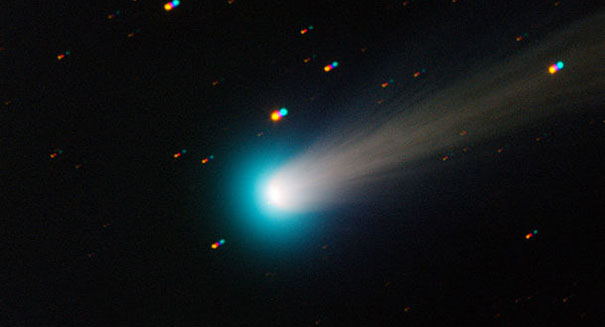
Comet ISON may be dead, but it certainly isn't forgotten.
For a ball of ice getting perilously close to the hottest thing in the solar system, there was more doubt and discussion surrounding Comet ISON’s perihelion than one might expect. Would it survive unscathed? Would it slingshot back on a collision course with Earth, removing all living beings from this mortal coil? Would it fizzle, melt and disintegrate, as any reasonable person would expect? The last one, mostly, but that doesn’t mean scientists weren’t able to gather a lot of valuable information.
Given ISON’s widespread publicity and spectacular destruction (were the comet an NFL player, Gregg Easterbrook would surely refer to it as a glory-seeking draft bust), its observation became a worldwide effort, both among scientists and amateur astronomers alike. The unprecedented amount of data they were able to gather will inform scientists for years to come.
On Dec. 10, 2013, researchers presented science results from the comet’s last days. They described how this unique comet lost mass in advance of reaching perihelion and most likely broke up during its closest approach, as well as summarized what this means for determining what the comet was made of.
“The comet’s story begins with the very formation of the solar system,” said Karl Battams, an astrophysicist at the Naval Research Lab in Washington, D.C. “The dirty snowball that we came to call Comet ISON was created at the same time as the planets.”
ISON spent most of its life milling around our solar system in the Oort cloud until something happened a few million years ago to change its path, like the passage of another star. Russian astronomers Vitali Nevski and Artyom Novichonok were the first to observe the comet some 585 million miles away from Earth in September of last year.
When comet scientists mapped out Comet ISON’s orbit they learned that the comet would swing within 1.1 million miles of the sun’s surface, making it what’s known as a sungrazing comet, providing opportunities to study this pristine bit of the early solar system as it lost material while approaching the higher temperatures of the sun. With this knowledge, an international campaign to observe the comet was born.
“The size of ISON’s nucleus could be a little over half a mile across — at the most. Very likely it could have been as small as several hundred yards,” said Alfred McEwen, the principal investigator for the HiRISE instrument at Arizona State University, in Tucson. This was small as far as comets go, meaning ISON’s chances for surviving perihelion were questionable prior to the event.
By fitting models of the dust tail to the actual observations from NASA’s Solar Terrestrial Observatory, or STEREO, and the joint European Space Agency/NASA Solar and Heliospheric Observatory, or SOHO, comet scientist Geraint Jones showed that very little dust was produced after perihelion, which may suggest that the comet’s nucleus had already broken up by that time.
“The fact that ISON did not show oxygen despite how close it came to the sun provides information about how high was the evaporation temperature of ISON’s material,” said Dean Pesnell, project scientist for SDO at NASA’s Goddard Space Flight Center. “This limits what it could have been made of.”
While observers were optimistic about the possibility of a spectacular light show as ISON rounded the sun, those dreams were ultimately dashed with the comet’s destruction. Call it the Ryan Leaf of the cosmos – a bright prospect with ultimately wasted potential.

Leave a Reply